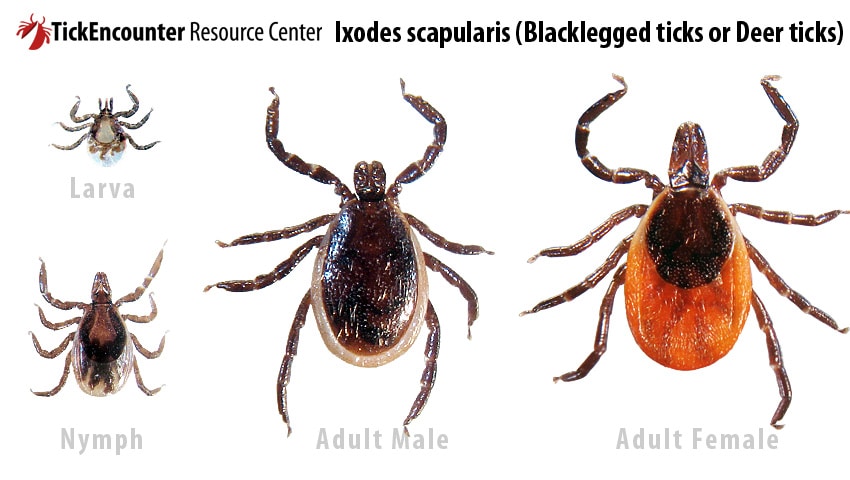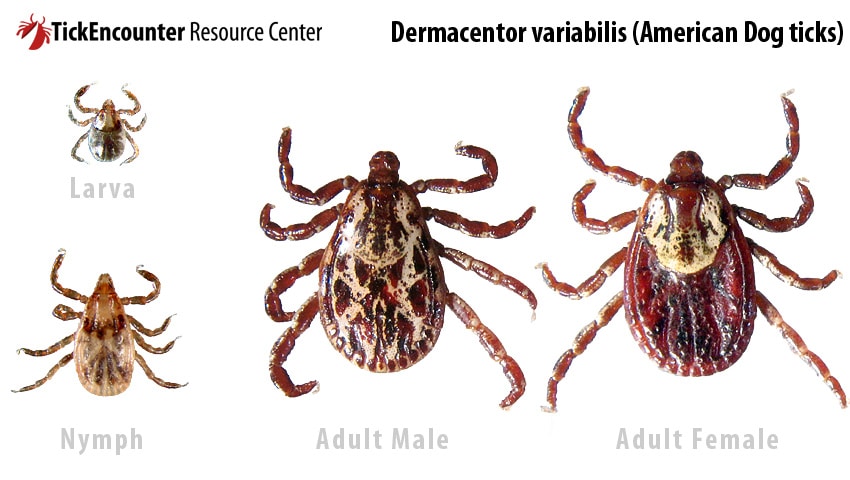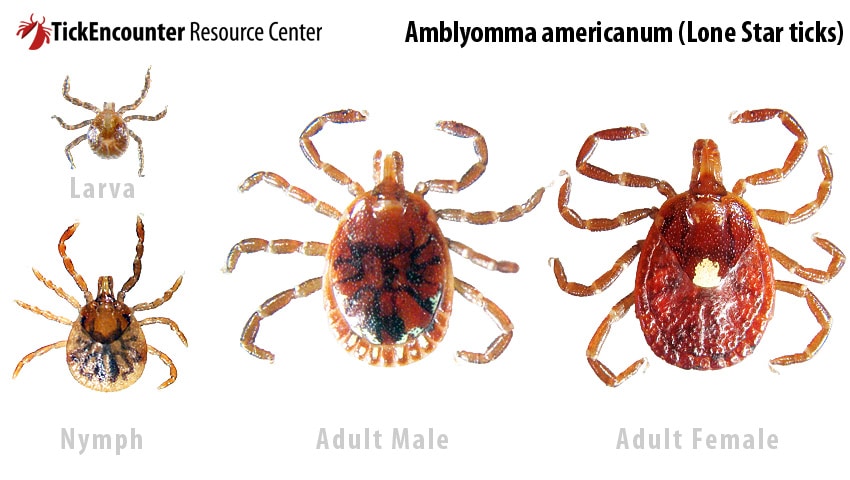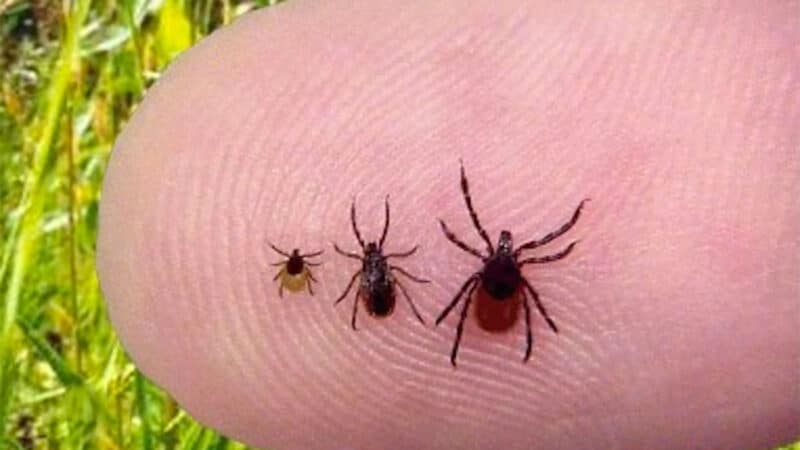by Dr. Sarah Treanor Bois
Director of Research & Education at the Linda Loring Nature Foundation
Ticks are as part of life on Nantucket as fog, summer traffic, and sand. That’s not a statement meant to scare people away. It’s a fact of life. Taking preventative and proactive measures will help ensure the health of you, your family, and your pets. First, it is important to know what we have on-island and what the potential dangers, if any, actually are.
Deer Ticks
Blacklegged ticks (a.k.a Deer ticks) take 2 years to complete their life cycle and are found predominantly in woody, shrubby habitats. Research has shown that they prefer the humidity of understory shrubs. Their numbers rely greatly on the distribution of its reproductive host: white-tailed deer. Both nymph and adult stages transmit diseases such as Lyme disease, Babesiosis, and Anaplasmosis. On Nantucket, this is our most common tick.

Dog Ticks
American Dog ticks are found predominantly in areas with little or no tree cover, such as grassy fields, as well as along walkways and trails. These used to be more prevalent on the island, but are less-frequently encountered now. They feed on a variety of hosts ranging in size from mice to deer, and nymphs and adults can transmit diseases such as Rocky Mountain Spotted Fever and Tularemia, though these are less commonly encountered than other tick-borne disease s.

Lone Star Ticks
This tick species is a more recent find in our region. Prevalent in the southeastern US, their distribution has been expanding with global climate change. Previously only known from a few areas of Massachusetts, lone star ticks (LST) now have confirmed breeding populations in Cape Cod, Martha’s Vineyard, and Nantucket.
Lone star ticks are known to be more aggressive than the deer and dog ticks. They actively “hunt” down a host instead of passively hoping one walks by. Lone star ticks, fortunately, don’t transmit Lyme’s, but they have their own unique set of diseases: they carry tularemia, human ehrlichiosis, and STARI (southern tick associated rash illness). The most sensational headline that gets repeated, with a hint of truth, is that the LST bite can make you allergic to red meat (anywhere from hives to anaphylactic shock). The good news, however, is that LST’s are less likel y to carry pathogens than deer ticks.

Lymes, Babesiosis, and Ehrlichiosis
Lyme disease is caused by an infection with a spirochete (a type of bacteria) which can be transmitted to people by bites from nymphal and adult black-legged ticks. Many of the symptoms of early Lyme’s mimic flu-like symptoms. Other tick-borne diseases passed on through ticks include human Babesiosis and Ehrlichiosis. Symptoms are similar for all three infections, and you can have co-infections, but treatments differ for each disease. When going to the doctor with a tick bite, confirm that you are tested for all possible tick-borne diseases. It’s important to be treated early if you test positive to prevent later, more serious problems.
Powassan Virus
This tick-borne illness has been in the news lately despite its rarity. Approximately 100 cases of Powassan virus disease were reported in the United States over the past 10 years and there were only 16 reported cases in Massachusetts. Unlike Lyme and other tick-borne bacterial infections, Powassan is a virus for which there is no treatment except supportive care. It is spread via the blacklegged tick. No cases of this disease have ever been reported on Nantucket.
For a great online resource that can answer most of your tick questions and will even go the extra mile, check out the Tick Encounter Resource Center at tickencounter.org, out of the University of Rhode Island. It offers a plethora of regional tick information based in science and with important information from the CDC. Not only is it a great source of information, but you can participate! Have a tick? Take a photo and send it in. The information they gather through volunteer participation allows TERC to create maps of infestations and calculate a Tick Encounter Index.
Several friends have remarked recently about finding nymphs on themselves after a walk. Young ticks, or nymphs, are most active in the warm weather months which is why we’re seeing them more now. Adult ticks are most active during the fall and spring, but can also be seen at other times of the year. Nymphs are difficult to identify at this stage, but best to avoid them altogether. After a recent day “in the field,” I found my shins covered with 10-20 tiny nymphs. I thought it was mud splatter until I realised it was bumpy. I must have walked by a hatch. The nymphs are easy to pick off and can even be removed with a lint roller or duct tape.
So you found a tick on you. Now what?
- Take it off. If it wasn’t biting you, pick it off and throw it in the toilet. Putting it between two pieces of tape and tossing in the garbage also works. Just don’t flick it back into your surroundings, especially if you’re inside. One less tick is still one less tick!
- If it is attached, try to remove it completely. This means you want the head out. If it only bit recently, it should be easy to do. Tweezers work well, but you can pick up any number of tick removal tools at pharmacies around the island.
- If you know the tick was only attached for 24 hours or less, treat the spot like a mosquito bite and go about your day. If you’re worried it may have been attached longer, check in with your doctor or the clinic at the Nantucket Cottage Hospital. Caught early and treated, you may never experience any symptoms. The Nantucket Cottage Hospital has good information about tick disease treatment and prevention at nantuckethospital.org/health-wellness-services/tickborne- disease.
If you happen to have the tick that bit you, don’t bother bringing it to the hospital, you can, however, send it in to be tested. TERC now partners with the UMASS Laboratory of Medical Zoology and their tickreport.com to offer tick testing. You can contribute to science and send the tick in for testing yourself. Not only will you get a report of what pathogens the tick may have been carrying, but you are contributing to important research. Tick Report was born from the mind of Dr. Steven Rich. As a microbiologist studying pathogens and tick-borne diseases, he heard from people who are truly concerned about the “tick epidemic” in their areas. Tapping in to the concerns of citizens allows Dr. Rich’s lab to collect a multitude of data while providing a service to interested people.
After I found a lone star tick on me in 2015, I called Dr. Rich and sent in my tick. The results came back in a few days and all was well. My tick was negative for every possible disease. Phew!
On Nantucket, multiple researchers are studying all aspects of ticks; tick biology, species and populations, tick-borne diseases, how to reduce the populations, and reduce disease transmissions. There may be some overlap, but, as with all scientific research, studies build upon each other. We all benefit when there are m ore researchers studying these issues.
Prevention is the best treatment:
• Avoid known tick habitats: brushy and moist areas (try to stay on the path)
• Tuck your pants inside your socks
• Use repellant. There are many options for sprays or inoculated clothing.
• Regularly check yourself and your family for ticks. Pay close attention to armpits, groin, and back.
• Treat your pets with medications or tick collars to repel ticks.
• Support tick research where possible. The more we know, the better prepare d we can be.
Don’t forget to enjoy Nantucket! With some preventative measures and a good tick check at the end of the day, you can still enjoy the wonderful nature Nantucket has to offer.



